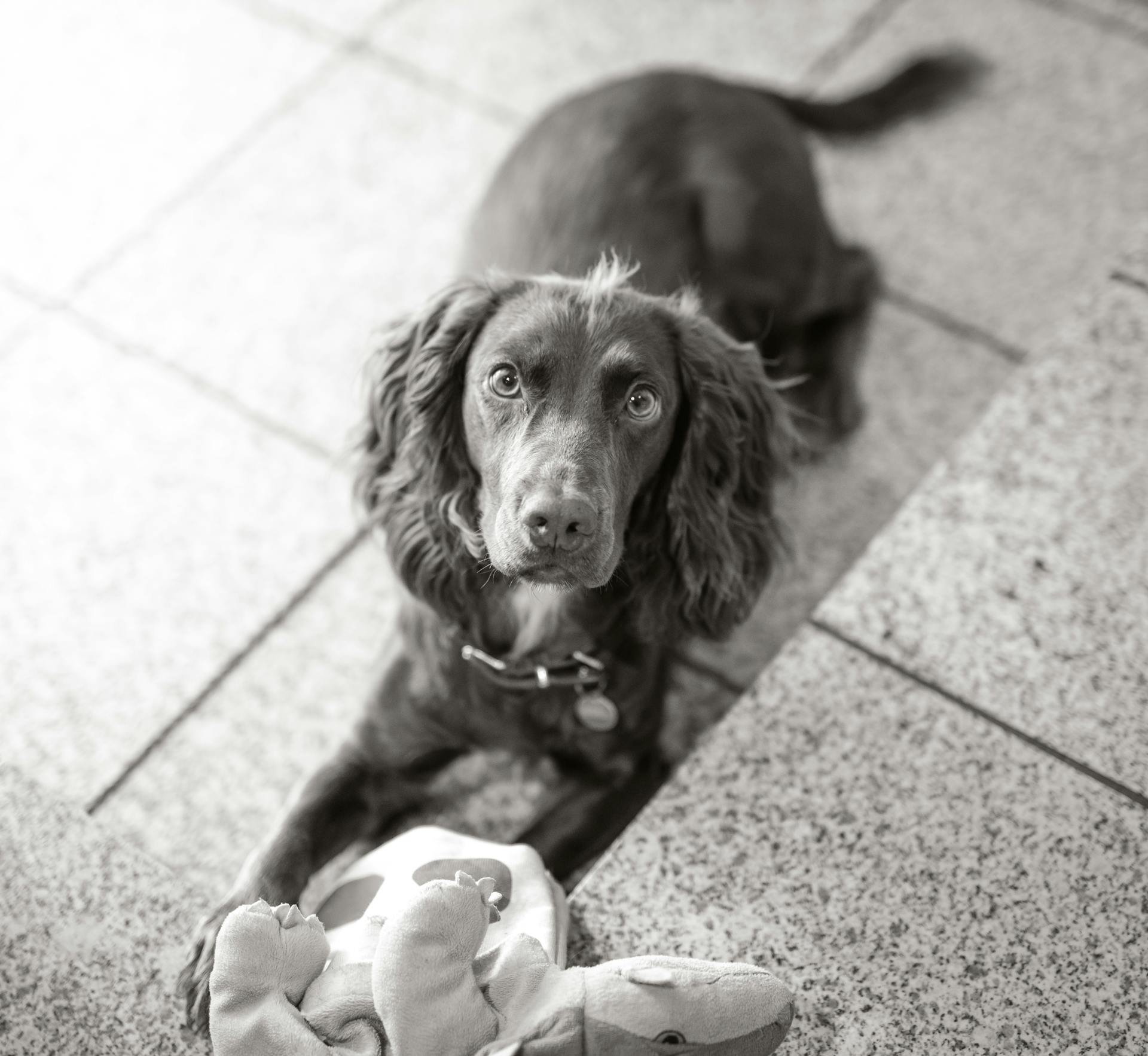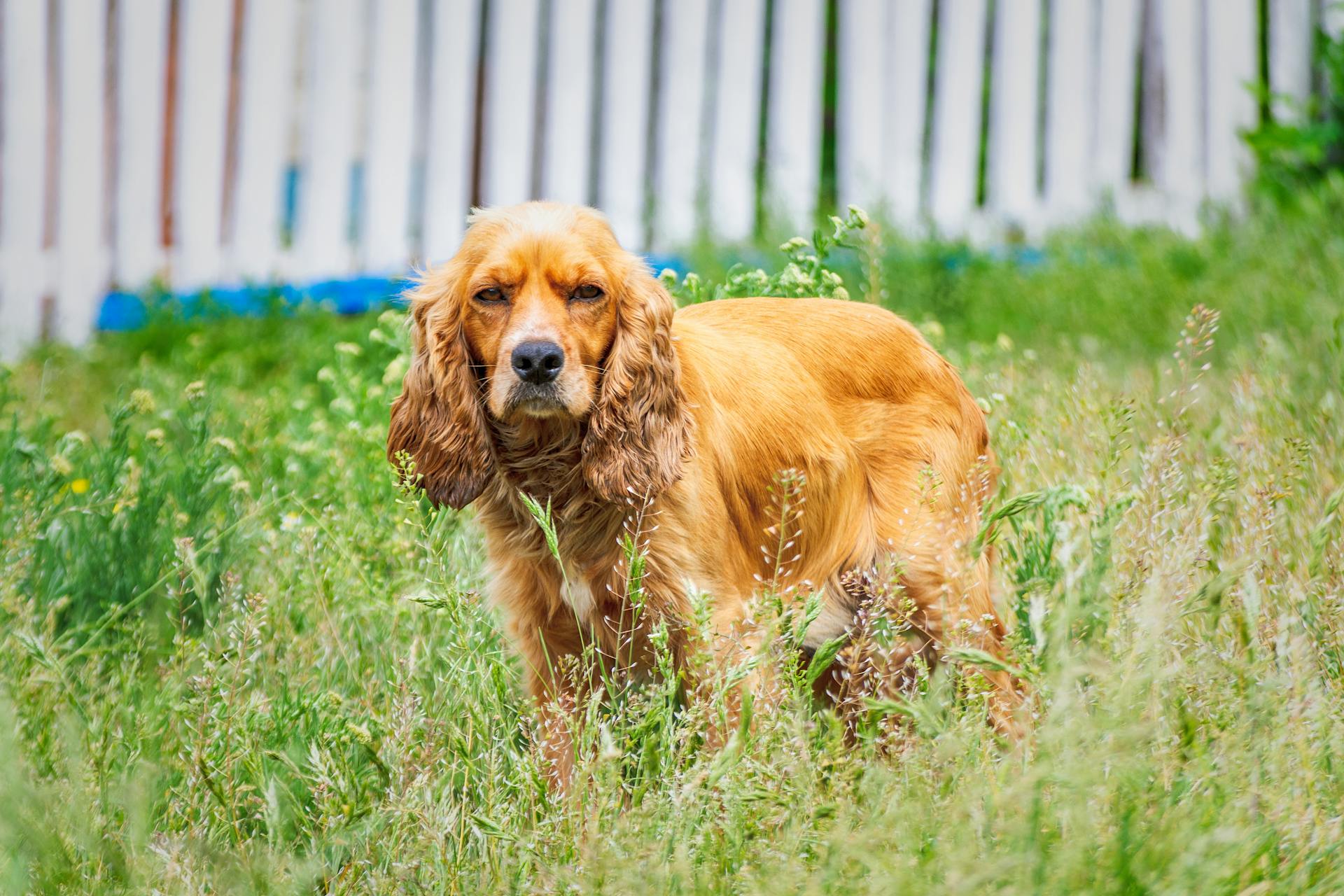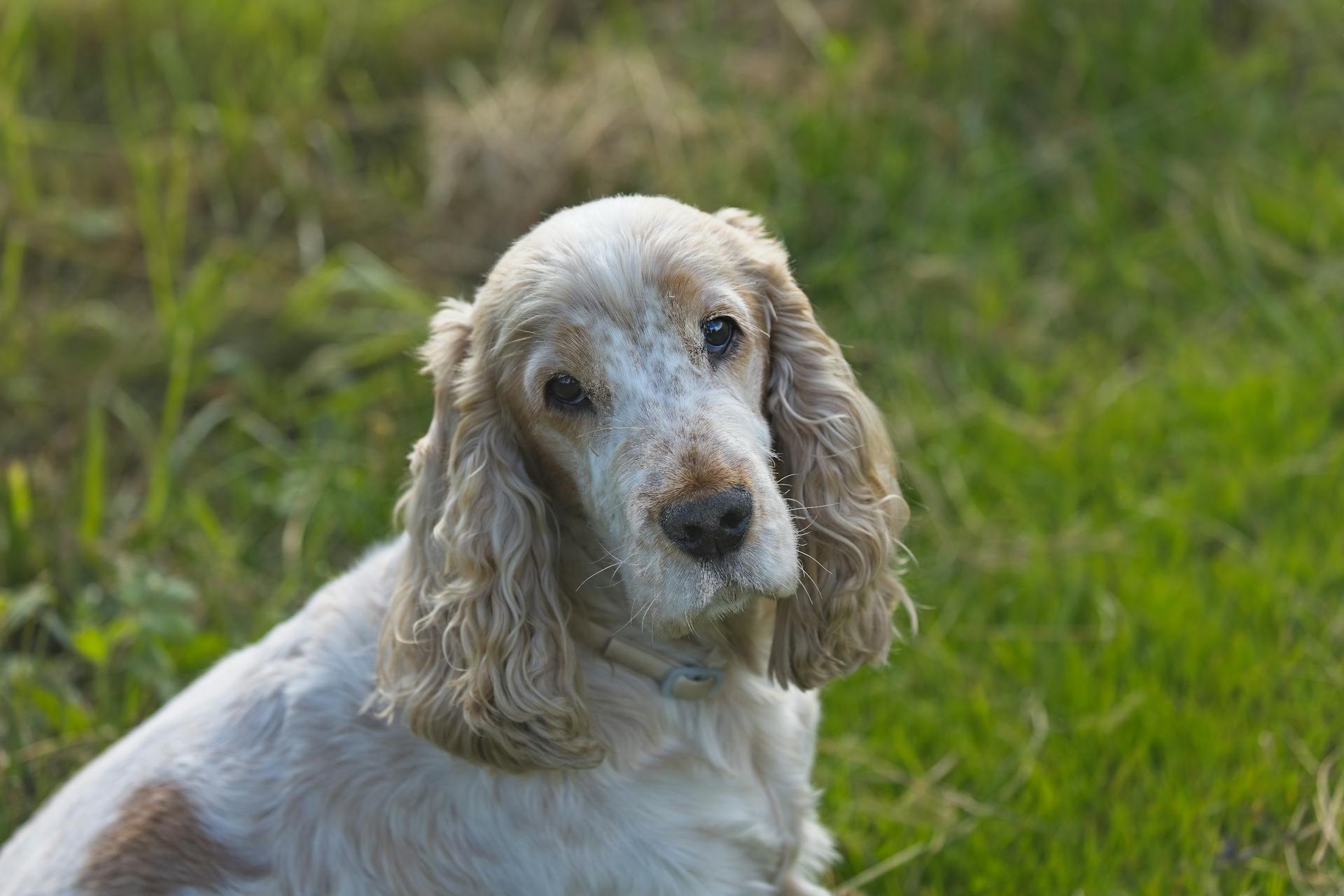
The English Cocker Spaniel Black and White is a stunning breed, and if you're considering bringing one home, you're probably eager to learn more.
They have a medium-length coat, which requires regular grooming to prevent matting and tangling.
Their friendly, outgoing personalities make them a great fit for families with children.
English Cocker Spaniels are generally good with children, but as with any breed, it's essential to socialize them well to ensure they're comfortable around kids.
They need regular exercise to stay happy and healthy, but they're not high-energy dogs and can adapt to apartment living if necessary.
History and Origins
The English Cocker Spaniel's history dates back to the 16th century, with spaniels being prized for their ability to assist with hunting game birds and waterfowl.
Initially, the only differentiation between cocker spaniels and springer spaniels was based on the size of the dog, with cocker spaniels being smaller and adept at hunting woodcock birds.
The spaniel family was split in two in the 1890s, with recognition for both the cocker spaniel and springer spaniel, and the breeds were independently developed and bred.
In the United States, a smaller, slightly blockier, and furrier version of the spaniel came into popularity, known as the American Cocker Spaniel, which stands in contrast to the slightly larger English spaniel.
The English Cocker Spaniel was officially recognized as a breed distinct from other spaniel breeds by The Royal Kennel Club in the UK in 1892.
The breed's popularity grew steadily in the early 20th century, both in the UK and abroad, due to its charm, intelligence, and versatility.
The American Kennel Club (AKC) recognized the English Cocker Spaniel as a separate breed in 1946, leading to further development and slight differences in appearance and temperament becoming apparent.
Today, the English Cocker Spaniel is more commonly found as a companion animal, adored for its affectionate nature, intelligence, and playful spirit.
Recommended read: American Kennel Club Lancashire Heeler
Physical Characteristics
The English Cocker Spaniel is a sturdy, compact and well-balanced dog. Its silky coat is medium-length, straight, and free from curls, though a slight wave is permissible. The coat is dense enough to protect against brambles without being too coarse.
Their height and weight vary slightly depending on sex, with adult males standing at 16 to 17 inches and weighing 28 to 34 pounds, while females stand at 15 to 16 inches and weigh 26 to 32 pounds.
The English Cocker Spaniel has a long, squarish nose, dark-colored eyes, and pendant ears. Their eyes convey a merry and alert demeanor, showcasing the breed’s intrinsic happiness and inquisitive nature.
Their ears are medium-length, set low, and lie close to the head. They are finely textured and covered with straight or slightly waved, silky hair. The muzzle is strong and square, showing depth and moderation in length.
Here are the breed standards for the English Cocker Spaniel from various kennel clubs:
The English Cocker Spaniel's tail will grow to a length of 8–9 inches when left to its own devices, but is often docked to about 4 inches.
Colour and Coat
English Cocker Spaniels are known for their stunning coats, and one of the most iconic color combinations is black and white. In fact, the United Kingdom's Kennel Club allows a small amount of white on the chest, making this color combination a classic choice.
The breed standard emphasizes that the black and white color combination is not only beautiful but also a sign of good breeding. English Cocker Spaniels with this color combination are often considered to be of high quality.
In terms of coat texture, English Cocker Spaniels boast a silky, medium-length coat that lays flat against the body. The coat is dense enough to protect against brambles without being too coarse, and feathering can be found on the chest, belly, legs, and ears, giving the English Cocker its distinctive and unexaggerated appearance.
Here are some common colors found in English Cocker Spaniels:
- Black
- Black and tan
- Liver Roan
- Black and White
- Orange and white
- Blue Roan
Coat Characteristics
The English Cocker Spaniel's coat is truly one of its most distinctive features. Its silky, medium-length coat lays flat against the body, giving it a smooth and elegant appearance.

One of the defining characteristics of the English Cocker's coat is its straight texture, which is free from curls. However, a slight wave is permissible, which adds to its charm.
The coat is dense enough to protect against brambles without being too coarse, making it a practical choice for a breed that loves to explore the outdoors.
Colour
The Colour of the English Cocker Spaniel is a vital aspect of the breed. The breed standard of the United Kingdom's Kennel Club states that in solid colours, no white is allowed except for a small amount on the chest.
The colour of the English Cocker Spaniel can vary greatly, with many different shades and patterns. The American Kennel Club has standards for features including the expression, neck, topline, and body.
Solid English Cocker colours come in a range of colours, including black, liver/brown, red/golden with black or brown pigmentation. These colours can also have Tan-points, adding a unique touch to the breed.
Expand your knowledge: English Cocker Spaniel Colors Tri Color
Parti-coloured cockers come in a variety of colours, including blue roan, liver roan, orange roan with black or brown pigmentation, and lemon roan with black or brown pigmentation. These colours are just as beautiful and unique as the solid colours.
Some colours are considered rare and controversial, such as the sable colour. This colour is classified by some countries as being a type of parti-colour on account of its mixed hair shafts.
The English Cocker Spaniel's colour can also be influenced by genetics, with some colours being more recessive than others. For example, lemon roan with a light brown pigmentation is the most recessive of all the roans.
Here are some of the solid and parti-coloured colours of the English Cocker Spaniel:
- Black
- Black and tan
- Liver Roan
- Black and White
- Orange and white
- Blue roan
Temperament and Personality
English Cocker Spaniels are known for their cheerful and playful personalities, often described as "merry." They thrive on attention and affection from their human family members and can become stressed if left alone for too long.
They're highly social dogs that get along well with people, children, and other pets, especially when socialized from an early age. However, they can be sensitive to loud noises and rough handling.
These dogs love to play and exercise, requiring regular physical activity to prevent boredom and frustration. If not provided with enough mental and physical stimulation, they may develop separation anxiety and stress barking.
Their friendly and gentle nature makes them an excellent choice for families with children, but it's essential to supervise interactions and teach kids how to properly interact with pets.
Temperament and Personality
English Cocker Spaniels are cheerful, playful dogs with a delightful personality, earning them the nickname "merry cocker." They're also extremely loyal to their people.
These dogs are natural explorers and excellent retrievers who love to play fetch with tennis balls or sticks. They thrive on physical and mental stimulation, so regular exercise is a must.
English Cocker Spaniels can get bored easily, so it's essential to keep them engaged with activities and training. They're intelligent canines that grasp new commands quickly.
With proper training and early socialization, English Cocker Spaniels can get along well with people, children, other dogs, and other pets. They're great with small children and can assimilate well into any pack.
However, they can be stressed by loud noises and rough treatment or handling. They're sensitive dogs that form deep bonds with their human family members, which can sometimes border on being clingy.
English Cocker Spaniels generally showcase a sociable side and tend to mingle well with other dogs, especially when they've been exposed through early socialization experiences.
Understanding the
English Cocker Spaniels are known for their intelligent nature, grasping new commands quickly and excelling in Obedience and Agility Trials. This intelligence is a testament to their innate smarts.
Their balanced structure is essential for efficient movement in the field, thanks to their well-proportioned front structure. This balance is crucial for their overall performance.

With a merry disposition, English Cocker Spaniels are a joy to be around, making them a great companion for families. Their friendly nature shines through in their interactions with others.
Their breed basics include a balanced structure, which is key to their agility and strength. This physical aspect is just one part of what makes them such wonderful companions.
Care and Maintenance
English cocker spaniels are relatively low-maintenance dogs, but they do require regular grooming to prevent matting and tangling of their beautiful, silky coats. This breed sheds moderately, so brushing at least two to three times a week can help reduce the amount of hair left around the house.
To keep their coat looking its best, English cocker spaniels need to be brushed regularly with a pin brush or slicker brush. This will help remove loose hairs, prevent matting, and distribute natural skin oils, giving the coat a healthy sheen.
English cocker spaniels are prone to ear infections, so regular ear cleaning is crucial. Owners should check and clean the ears weekly with a vet-recommended solution to prevent infections.
In addition to regular grooming, English cocker spaniels need regular nail trimming and tooth brushing to prevent dental issues. They also require occasional trims, especially around the ears, feet, and tail, to maintain a neat appearance.
Here's a summary of the grooming needs of English cocker spaniels:
By following these grooming tips, you can help keep your English cocker spaniel looking and feeling its best.
Training and Behaviour
English Cocker Spaniels are intelligent and eager to please, making them relatively easy to train. They respond well to positive reinforcement, such as treats, praise, and play, which can yield impressive results in shaping their behavior and teaching new commands.
To train an English Cocker Spaniel, it's essential to be patient and consistent. They have a sensitive nature, so harsh training methods can cause fear and anxiety, leading to undesirable behaviors like submissive urination or separation anxiety.
Curious to learn more? Check out: How to Train a German Shorthaired Pointer to Hunt
English Cocker Spaniels typically require regular exercise, such as daily walks and a few times per week of open areas to run and burn energy. This is crucial to keep them in shape and prevent boredom and destructive behavior.
Here are some dog sports and activities that English Cocker Spaniels excel in:
- Agility: English Cocker Spaniels shine in Agility competitions, navigating through tunnels, jumping over hurdles, and weaving through poles with gusto.
- Obedience: The English Cocker's desire to please and innate intelligence makes the breed a stand-out in Obedience Trials.
- Flyball: This is a relay race that involves hurdles and a spring-loaded mechanism that releases a tennis ball for the dog to catch and retrieve.
English Cocker Spaniels can be prone to separation anxiety if left alone for prolonged periods, but with proper training and gradual increases in alone time, they can often handle moderate durations without company.
Left Alone?
English Cocker Spaniels are social dogs that require companionship and may not enjoy being left alone for long periods.
Doing so can lead to separation anxiety in these dogs.
With proper training, English Cockers can often handle moderate durations without company.
It's essential to ensure they have toys and activities to keep them occupied when left alone.
Training
Training an English Cocker Spaniel is a joy, as they're outgoing, friendly, and biddable dogs that desire to work and learn.
English Cocker Spaniels are intelligent and eager to please, making them relatively easy to train. Basic obedience lessons can begin when puppies are about 8 weeks old. They respond well to positive reinforcement, so be sure to use treats, praise, and play as rewards.
Harsh training methods can be detrimental to their confidence and trust, so it's essential to use a gentle and consistent approach. With younger English Cockers, socialization is key to help them become well-adjusted for future adventures.
To overcome their occasional stubborn streak, persistence, patience, and consistency are crucial. Training them to understand commands like "quiet" or "enough" from a young age can help manage their vocalizations.
Here are some key training tips for English Cocker Spaniels:
- Keep training sessions fresh and interesting to keep them engaged.
- Use positive reinforcement techniques, such as treats and praise.
- Be patient and consistent, as they may have an occasional stubborn streak.
- Train them to understand commands like "quiet" or "enough" from a young age.
English Cocker Spaniels are natural athletes and thrive when engaged in activities and dog sports. With proper training, they excel in Agility, Obedience Trials, Hunting and Field Trials, Flyball, Conformation Shows, and even Therapy Work.
Health and Wellbeing
English cocker spaniels can be prone to inherited health problems, so it's essential to research responsible breeders who test their parent dogs for genetic issues.
Many breeds experience allergies to foods and environmental allergens, and your veterinarian can test for specific allergies.
Benign tumors, such as abnormal growths or cysts, can develop on your dog's skin, and tests should be performed to rule out cancer and other diseases.
Cataracts, or cloudy spots on the eyes, can impair your dog's vision, and regular eye check-ups can detect the disease before the dog shows any signs of blindness.
Progressive retinal atrophy is an eye condition that affects the dog's retina and eventually leads to blindness.
Ear infections are common in dogs with floppy ears, and owners should check and clean the ears regularly to prevent problems.
Hearing loss and deafness are risks for particolored English cocker spaniels due to abnormal genes.
Luxating patella causes the kneecap to pop in and out of place, and may require surgery in severe cases.
Intriguing read: German Shorthaired Pointer Allergies
Hypothyroidism impairs the body's ability to produce important hormones.
To minimize the risk of adopting a dog with these health problems, research breeders who provide tests on each parent dog for:
- Hips and knees tests from the Orthopedic Foundation for Animals
- Tests from the Canine Eye Registry Foundation
- A test for hearing from the Orthopedic Foundation for Animals that measures brainstem auditory evoked response (BAER)
Regular veterinary check-ups can detect health issues before they become severe, ensuring a longer, healthier life for your dog.
Some common health concerns that affect English cockers include progressive retinal atrophy, hip dysplasia, otitis externa, familial nephropathy, cardiac issues, and gastric torsion.
Frequently Asked Questions
Are English cocker spaniels good dogs?
English cocker spaniels are friendly, loyal, and playful companions suitable for families with children or adventurous adults. They make great pets for those looking for a cheerful and biddable breed.
Sources
- https://en.wikipedia.org/wiki/English_Cocker_Spaniel
- https://gunner.com/blogs/pack/english-cocker-spaniels-breed-profile
- https://www.dailypaws.com/dogs-puppies/dog-breeds/english-cocker-spaniel
- https://www.thesprucepets.com/english-cocker-spaniel-full-profile-history-and-care-4707712
- https://showsightmagazine.com/dog-breeds/english-cocker-spaniel/
Featured Images: pexels.com


